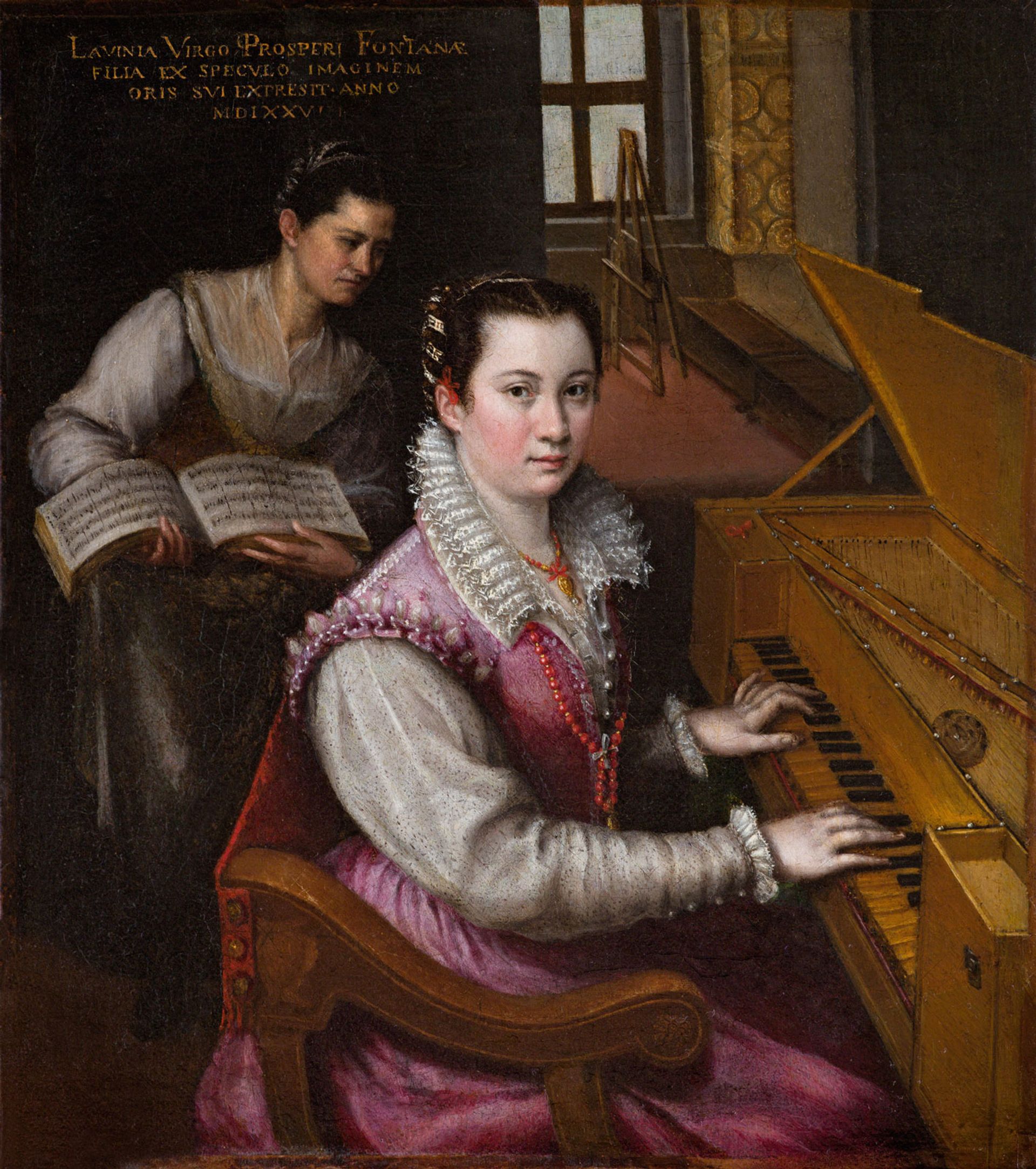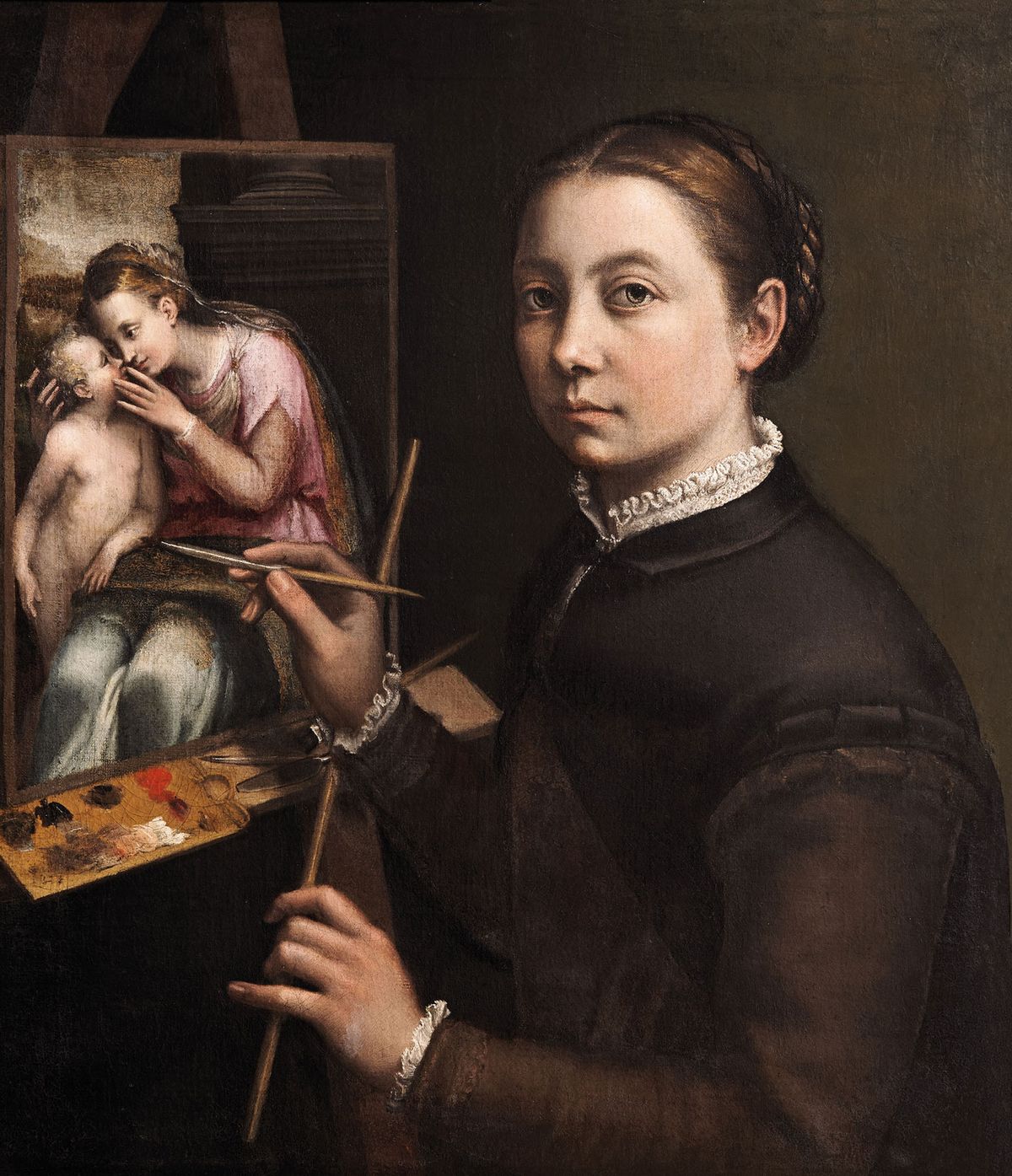Sofonisba Anguissola (1535-1625) and Lavinia Fontana (1552-1614) are two artists I didn’t know. They didn’t know each other, either. Both were Italian, Anguissola the daughter of a Cremonese nobleman and Fontana the daughter of Prospero Fontana, part of the Bolognese art community that included the Carracci family. Lavinia, as far as we know, is the first woman in Europe to own and operate her own studio. Anguissola served Isabel de Valois, the wife of Philip II, as a lady in waiting before doubling as a Spanish court painter in the era of chief court painter Alonso Sánchez Coello.
Sofonisba Anguissola and Lavinia Fontana: a Tale of Two Women Painters at the Museo Nacional del Prado is beautifully done and well worth seeing. This exhibition gives us good work to see—good, solid, once or twice beguiling. Each, though, would wither in the spotlight of her own retrospective. It’s as much about biography as art.
Anguissola is the better of the two. Self-Portrait at the Easel (around 1556-57) is a religious picture—high in the art hierarchy, it shows how ambitious she was—but it’s self-promotional. Anguissola is a very good portraitist, and in doing dozens of self-portraits she found a marketing strategy. No one, after all, would hire a dentist whose ads show him missing a front tooth. She looks serious, intelligent, and handsome, and paints in a conservative style. A radical Isadora Duncan might have shed corsets and petticoats to dance in her bare feet but Anguissola signals she’s mainstream.

Lavinia Fontana’s Self-Portrait at the Spinet (1577) Accademia Nazionale di San Luca
Fontana’s Self-Portrait at the Spinet (1577) was probably painted as her marriage portrait. It’s a modestly complex and competent picture. Michael Cole’s good essay, in the English-language catalogue, argues that these two well-born women were educated in music and textiles. In their cases, painting was an unorthodox segue but logical, given that Fontana’s father was a painter and Anguissola’s an art patron.
Anguissola and Fontana painted portraits, religious, and mythological pictures. Fontana’s multi-figure pictures like Family Portrait (around 1558) has vivid likenesses and plenty of gestures. It’s a devotional picture honouring a dead paterfamilias. For all the gesturing, no one is saying a word. It feels like a sign language class. Its cramped composition is awkward but not distressingly so. Packed with fancy lace painting and with a dog in the centre, it’s charming and both formal and intimate.
Fontana was in Rome after 1600, specialising in portraits of rich Romans that aren’t in the show. I suspect she painted a lot of out-and-out clunkers that the curators screened. That said, I loved Galatea and Cherubs Riding on a Sea Monster, an oil on copper from around 1590. It combines air power—the collapsed sail of her boat becomes a weird wind tunnel—and the monster’s muscular, serpentine sea power to conceive a sense of propulsion sufficient to move the juicy but hefty nymph and her entourage.
Anguissola’s portraits of Bianca Ponzoni and Pietro Manna (both 1557), are intense but she’s following Giovanni Moroni and her teacher, Bernardino Campi. She’s playing it safe. She married in 1580—basically ending her painting career—and moved to Genoa until 1615, when her husband got a job as Genoese consul in Palermo.
In 1624, nearing 90 years of age, she got a visit from Antony van Dyck in Palermo, who wrote about it in his diary and painted her portrait. The catalogue makes too much of this, presenting it as a young artist’s pilgrimage to meet “a hugely important artistic and historical reference and an example to follow”. Van Dyke was in Sicily for more than a year, did lots of work there, and was a networker extraordinaire. He met anyone who’d meet him. He was always on the move and on the make. What was probably more relevant to the 24-year-old artist, was the period Anguissola spent in Genoa, where Van Dyck had just painted plenty of local aristocrats. There, she was the art hostess with the mostest so they had many people and places in common.
It’s a nice show. The catalogue dresses “derivative” and “diligent” in as much finery as it can before retreating to a long chapter on technical analysis and object entries heavy on documentation. I would have cut the exhibition’s size by a third.


